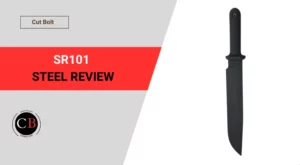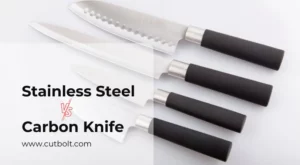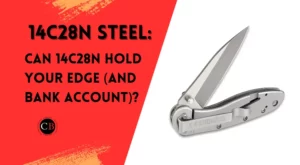You may have heard of SK5 steel. SK 5 steel is a carbon steel of Japanese origin. It also goes by the name Nihon steel, SK meaning “Steel Kougou” or you can say “tool steel”.
Now what is SK 5 steel actually?
SK5 is a low to medium range Japanese carbon steel and an equivalent of 1080 steel. It is used in a variety of tools such as razor blades, utility knives, scalpel blades, scrapers, long edge tools due to its workability, hardenability, price and other characteristics.
Table of Contents
Chemical composition of SK-5 steel
SK 5 steel also know as SK 85 steel.
Here is the SK5 steel composition, it will help you to under stand what is SK5 steel better:
| Element | Portion | Effect |
| Chromium | 0.3% | Improves wear resistance, heat resistance and scale resistance. It increases tensile strength because it acts as a carbide former. Use of rust-free or stainless steel, as it increases corrosion resistance from a mass proportion of 12.2%. Reduction in weldability. |
| Carbon | 0.8 – 0.9% | Increasing hardness and tensile strength. In larger quantities, increase in brittleness and reduction in forgeability and weldability. |
| Copper | 0.25% | Improving weather resistance (surface oxidation). |
| Manganese | 0.5% | Improves hardness and tensile strength. |
| Nickel | 0.25% | Nickel increases tensile strength and yield strength. From 8% increase in corrosion resistance. |
| Phosphorus | 0.03% | Increases tensile strength, hardness and corrosion resistance but also brittleness. |
| Sulfur | 0.03% | Increases machinability but also brittleness. |
| Silicon | 0.15 – 0.35% | Improves strength. |
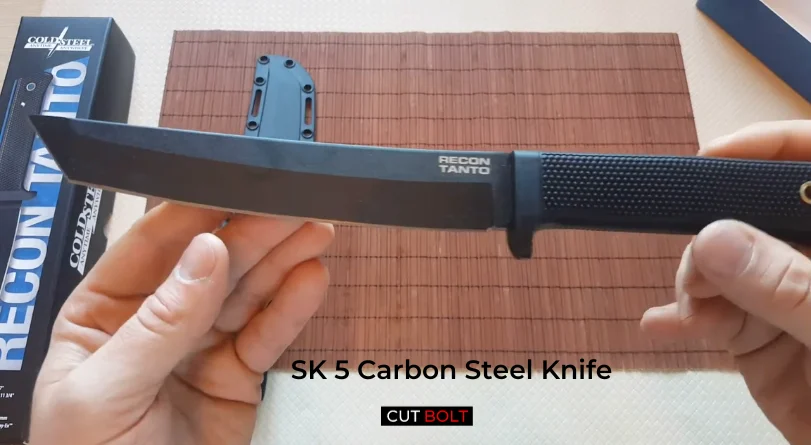
With almost 1% carbon, the carbon content of this type of steel is very high. The direct result of this increased carbon content is higher steel hardness – more hardness means better wear resistance.
The chromium content of SK5 steel is only 0.3%, well below the minimum amount of 10% required to classify a steel as stainless. However, the low chromium content has a positive effect on the hardness.
The silicon content is between 0.15 and 0.35% and simply makes the steel stronger.
SK 5 steel has up to 0.5% Manganese and, like carbon, contributes to increasing hardness. However, the proportion was intentionally kept low – too much manganese can increase the brittleness of the material.
A proportion of 0.25% nickel is also part of the composition of this steel. This also contributes to its hardness. However, it also increases the brittleness of the steel.
0.03% phosphorus contributes to the strength of the steel.
0.03% sulfur makes SK5 steel easier to process, including by machine.
Advantages of Nihon (SK 5) steel
- SK 5 steel is a carbon-enriched steel that provides your knives with a rigid cutting edge that resists wear.
- It has a hardness of approximately 59 HRC, which ensures long-lasting sharpness and precise cuts.
- When sharpened, Nihon steel supports a more accomplished finish than classic Western steels.
Disadvantages of Nihon steel
- As the alloy is enriched with carbon, it requires careful maintenance of your knives. The dishwasher should not be used, and drying must be immediate after cleaning. Find all our maintenance tips for carbon knives here!
- The rigidity of SK5 steel means that it is rarely used alone because it can be sensitive to breakage. This is why it is often covered with a layer of softer steel which balances its hardness and protects it.
- Sharpening Nihon steel requires a little practice to be done with a whetstone.
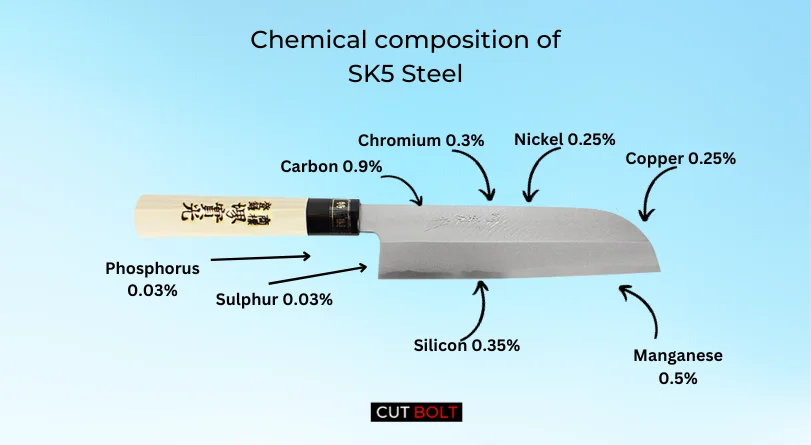
Is SK5 steel a stainless steel? Does it rust?
SK5 steel is not a stainless steel. As a stainless steel, it should contain a maximum of 0.025% each of phosphorus and sulfur. And it would be “stainless” if it contained 10.5% or more chromium, which it does not (it contains a maximum of 0.30%).
What is the hardness (HRC) of SK5?
The highest hardness rating I have found for SK5 steel is 62 HRC, making it a very hard steel. That said, its hardness is usually more in the 57-60 HRC range.
The reason for its high hardness is largely (but not only) due to its high carbon content. The high hardness gives this steel excellent abrasion and wear resistance, making it ideal for making reliable blades for hunting, hiking, bushcrafting and other demanding outdoor activities.
Note: hardness of SK5 steel can vary from manufacturer to manufacturer, depending on factors such as manufacturer-specific heat treatment. Therefore, you should not be surprised to find SK5 steel with a hardness of “only” 55 HRC.
Properties of SK5 steel
The chemical properties of steel go hand in hand with its properties in application. According to the chemical composition and hardness of SK5, this AEB-L steel offers the following properties:
1. Edge retention
SK5 steel offers an impressive cutting edge because it is carbon steel with almost 1% carbon content, which makes it a very hard steel with high cutting edge strength.
Simply put, this means that an SK5 knife will not dull easily and will maintain a super-sharp edge even with regular use. In other words, the owner of an SK5 knife spends more time using his knife and less time resharpening it.
2. Corrosion resistance
SK5 offers acceptable corrosion resistance, it is not bad, but it needs care to prevent rust and corrosion.
SK5 steel is NOT stainless, but offers acceptable corrosion resistance thanks to the small amount of chromium, but basically requires a bit more care than other (stainless) knives. Also, it should be mentioned that many knife manufacturers now add an anti-corrosion coating to their SK5 blades to improve their anti-corrosion properties.
3. Wear resistance
The wear resistance of SK5 is excellent thanks to the fine grain and carbides.
4. Sharpness of Nihon (SK-5) steel
The rule is that the harder the steel, the harder it is to sharpen. SK5 can become very hard (62-63 HRC), which makes sharpening much more difficult. As a hard steel with a theoretical Rockwell hardness of up to 63 HRC (some even claim 65 HRC…), SK5 will definitely be a challenge to sharpen.
The good thing, however, is that the edge will last a long time, so you won’t have to sharpen it every day. Nevertheless, it is worthwhile to invest in adequate sharpening systems, or use machines right away, so that the knife can be sharpened much easier than with conventional wet stone sharpening methods.
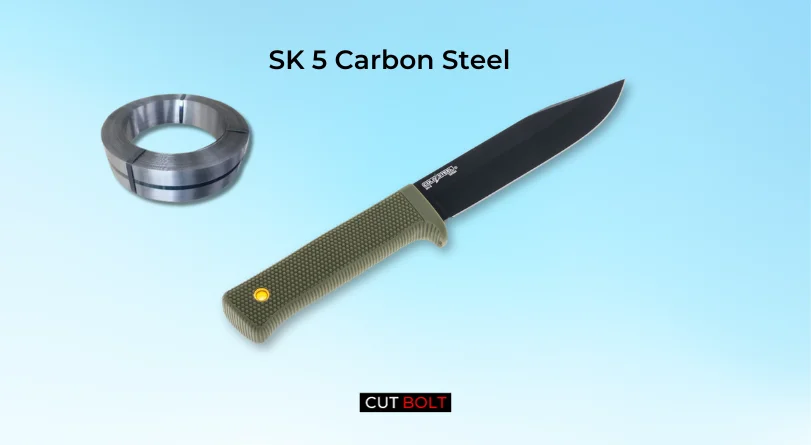
How tough is SK5 steel?
The harder the steel is, the less tough it becomes. It is no different with SK5 steel, which is manufactured in Japan. The high hardness of this steel makes it less tough. But it still has a reasonable amount of toughness, so it takes a lot before it splinters or breaks.
The bottom line is SK5 is a tough enough steel with great impact strength. Its hardness and toughness are well balanced, but at the expense of corrosion resistance – all three properties are unfortunately difficult to combine in one steel.
Is SK5 steel good for knives?
In short, YES, SK5 steel is a great carbon steel for knives– It offers great toughness and hardness, making it a good choice for survival and hunting knives, but it also does well in the kitchen.
However, you need to take good care of it, especially due to its low corrosion resistance when used in humid environments. In addition, its quality also depends on the manufacturer and its manufacturing quality.
With a reputable manufacturer who understands his craft, you get a pretty good SK5 knife with great edge retention and high wear resistance. A good manufacturer will also make their knives in such a way that they are the best compromise between good sharpenability and the highest possible resistance to splintering and breakage.
One thing to expect with SK5 steel, however, is its comparatively high susceptibility to rust and corrosion, especially when used in wet or maritime environments. Here, in addition to the low chromium content, an anti-rust coating on the blade and, last but not least, proper care is crucial to enjoying an SK5 knife for a long time.
You can go through best steel for knife blade to learn more.
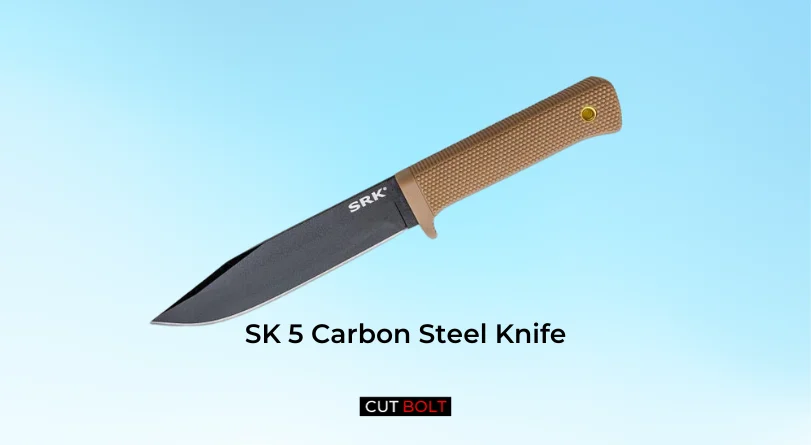
SK5 Steel – Equivalents
SK5 is very close to W2 and 1084 carbon steel. The respective chemical compositions are very similar, albeit more minimalist. They all offer what carbon steel is known for (and popular for): CUTTING DURABILITY and TIGHTNESS, with comparatively decent corrosion resistance, and in the lower to middle price range.
Comparison SK5 and other steels
To get an even better idea of how SK5 positions itself, let’s compare it to other popular steels in the knife industry. To do this, let’s look at material equivalent steels and alternatives to this steel.
SK5 steel vs 1095
1095 and SK5 are quite similar. They both have the same carbon content (1095 has a carbon content of 0.95%), but while 1095 can be a bit harder, SK5 is a bit tougher. The bottom line, however, is that both have fairly similar properties when used in a knife blade.
SK5 steel vs SK4
SK4 has an even slightly higher carbon content in its composition – up to 1% – which makes it even harder. For this reason, SK4 is more wear resistant and keeps its edge in good condition longer than SK5. However, it is still a bit more challenging to sharpen than SK5.
SK5 steel vs VG10
VG10 has several advantages over SK5. The steel is quite hard, but the vanadium in its composition compensates for the negative side effects of hardness in favor of its toughness. It also has a higher chromium content, which increases corrosion resistance. However, its high hardness means that it is not easy to sharpen. In addition, VG10 knives are very expensive compared to those made of SK5 steel.
Summary: What is SK-5 steel is it good for knife?
SK5 is a great steel: its edge stays sharp for a long time, it makes a great EDC knife, and the price is good. Of course, like pretty much everything, it also has a few downsides, such as its (theoretical) susceptibility to rust, but you can live with that, especially if the blade has an anti-corrosion coating.
I think many knife enthusiasts therefore share my opinion (especially the carbon steel faction …) that this is or can be a great blade steel. So who intends to buy a SK5 knife has my full blessing.

